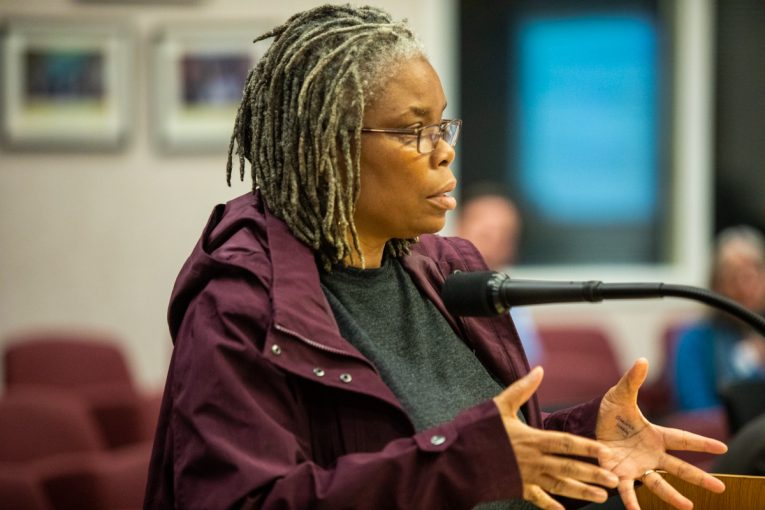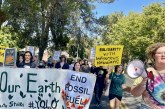

By Macy Lu
DAVIS — This month racial activist and UC Davis associate clinical professor, Jann Murray-Garcia, became the latest in a long-line of notable laureates to win the prestigious “Citizen of the Year” award.
Murray-Garcia is most reputable for creating an award-winning education and race documentary, helping establish the “Race and Social Justice in US history” course at the Davis High School, and developing the four-week Summer Institute on Race and Health at the University.
Murray-Garcia initially became active in Davis Joint Unified School District (DJUSD) out of concern for her children’s educational experience in a town population of only two percent African-American.
“Davis has a reputation for being a hard place to live as a black person, and black children have a hard time in school,” said Murray-Garcia. “I told my husband that if we move here, I’m going to have to be active in the schools.”
She made the decision based upon her knowledge that “schools become places where kids learn the world… Kids don’t know there is a minority until they go to school.”
With the help of school counselor Courtenay Tessler and social science teacher Peter Riley, Murray-Garcia recruited “three cohorts” of students over several years to help her create the 70-minute documentary, “From Community to the Classroom.” The documentary examines how children learn about race in one of the nation’s highest performing school districts.
The film begins by recounting two hate incidents committed by Davis High students in the early 2000s as well as testimonies from other children and youths of their encounters with racism.
It then examines the role Blacks for Effective Community Action (BECA), which Murray-Garcia led at the time and which was created in response to those incidents, had in combating racism among Davis young people.
Under her leadership, BECA compiled a 26 page research report “outlining racial disparity in academic achievement and discipline pattern” based on five years of data.
Notably, they found that “African-Americans, Latinos, and Native Americans were much less likely to have completed the course requirements to be able to apply for California public 4 year universities.”
These same groups were also “enrolled in the district’s gifted and talented programs at a fraction of the rate of white and Asian students…They were also much more likely to be suspended at least once during the last school year.”
One of the ways Murray-Garcia and her students hoped to address these issues and introduce conversations about race into the high school curriculum was through the social science course, “Race and Social Justice in US history.”
What amazed Murray-Garcia the most throughout the process of creating the course was how “[the kids] taught adults… People thought it was a political statement by adults, but when it came down to it, the kids chose to learn about this stuff.
“The kids…lobbied the school board for this class. In 2007, the school district told us if 29 kids didn’t sign up, they couldn’t pay for a teacher, so 108 kids signed up. I’m just so proud of that achievement, which belongs to so many people, including Kevin Williams, the history teacher who created it, [and] Mike Cawley the principal at the time.”
The “sense of possibility” young people exude and their courage in “challenging the status quo,” Murray-Garcia explained “is why I am a pediatrician.”
As an associate clinical professor at the Betty Irene Moore School of Nursing at UC Davis, Murray-Garcia’s passion for racial justice extends into her research and approach to higher education.
Together with Melanie Tervalon, Murray-García coined and developed the concept of Cultural Humility in her most cited publication, “Cultural Humility versus Cultural Competency: A Critical Distinction in Defining Physician Training Outcomes in Multicultural Education.”
The concept emphasizes employing self-evaluation and self-critique to “[redress] power imbalances” in patient-physician relationships and to “[develop] mutually beneficial partnerships with communities.”
One way Murray-Garcia has applied her own research to her teaching is by creating the Summer Institute on Race and Health, a four-week clerkship that explores how the social construction of race impacts public health, as well as co-founding another training program called Anti-Racism and Cultural Humility.
What ultimately makes them so “unique” she noted, is that “we get a lot of time to dialogue about our experience of race as individuals within our families and community as well as in the health system.”
The reason why she finds it so crucial to integrate discussions of race into medical education is because it first takes awareness of racial inequality at the systemic level and individual level in order to begin eliminating it.
“Historical scripts of distrust, of advantage, of privilege [are] just woven into…institutional systems,” said Murray-Garcia. “If you don’t see those operating in your interactions with patients, it’s going to be hard to interrupt those scripts of inequality.”
While Murray-Garcia’s record of service in Davis is impressive, her passion for racial activism actually began long before she even set foot in the city.
In fact, civil rights activism has been a “family legacy” of hers, beginning with her grandparents. It accounts for why she is dedicated to teaching others about race disparities in healthcare and children’s education today.
During an interview with the Vanguard, Murray-Garcia recalled how despite living in the “Jim Crow South,” her grandfather was “the president of the NAACP in Charleston” and her grandmother “was a community leader” despite being a sharecropper.
“These are the stories I’ve heard, and my mom in particular was very deliberate about teaching us about what was known then about African-American history,” she stated.
When asked how she felt about winning “Citizen of the Year” as a black woman after a year of intense racial turmoil, Murray-Garcia reflected on the time when she asked her father a similar question after the election of former President Barack Obama.
To her question of how her parents generation “lived through Jim Crow, all that lynching, all these things they saw,” her father replied with a simple yet profound message: “[We] always kept hope.”
“That’s my responsibility,” Murray-Garcia stated proudly. “If they could have hope during their time, then I can have hope during this time and keep moving forward.”

Macy is a junior from Orange County, CA, studying Communications and English at UC Davis. She loves meeting people, reading books, and writing creatively.




